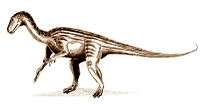1836 in paleontology
Paleontology or palaeontology is the study of prehistoric life forms on Earth through the examination of plant and animal fossils.[1] This includes the study of body fossils, tracks (ichnites), burrows, cast-off parts, fossilised feces (coprolites), palynomorphs and chemical residues. Because humans have encountered fossils for millennia, paleontology has a long history both before and after becoming formalized as a science. This article records significant discoveries and events related to paleontology that occurred or were published in the year 1836.
| |||
|---|---|---|---|
|
Dinosaurs
Newly named dinosaurs
| Taxon | Novelty | Status | Author(s) | Age | Unit | Location | Notes | Images | |
|---|---|---|---|---|---|---|---|---|---|
| Poekilopleuron bucklandii[2] | Gen. et sp. nov. | Valid | Jacques Amand Eudes-Deslongchamps | Middle Jurassic (Bathonian) | Calcaire de Caen | As shown in Ref.,[3] the genus and species were first named and described by Jacques-Amand Eudes-Deslongchamps in a report published in 1836, based on holotype material that is now destroyed. In 1837, Eudes-Deslongchamps published a more detailed account of this discovery in a monograph[4] which was also inserted next year in volume 6 of the "Mémoires de la Société Linnéenne Normandie".[5] | |||
| Palaeosaurus cylindrodon | Gen. et sp. nov. | Preoccupied genus, nomen dubium | Henry Riley, Samuel Stutchbury | Late Triassic, Rhaetian[6] | Durdham Down[6] | The name was preoccupied by a non-dinosaurian archosaur named by Geoffroy Saint-Hilaire in 1833. Palaeosaurus cylindrodon is the type species of the genus.[6] | |||
| Palaeosaurus platyodon | Sp. nov. | Preoccupied genus, nomen dubium | Henry Riley, Samuel Stutchbury | Late Triassic, Rhaetian | Durdham Down | Second species of the preoccupied genus Palaeosaurus, later renamed into the separate genus Rileya. | |||
|
Gen. nov. |
Valid |
Henry Riley, Samuel Stutchbury |
Durdham Down[6] |
Thecodontosaurus is the fourth valid dinosaur genus named. It was first excavated by Riley and Stutchbury in 1834, and they published a preliminary description in 1835. When they assigned the remains to a new taxon, which they named Thecodontosaurus, they did not assign a species. The genus was not originally recognized as a dinosaur, with Riley and Stutchbury finding it a saurian.[6] |
| ||||
gollark: Would you not just add up the base EMCs or something?
gollark: Why would it be solving simultaneous equations?
gollark: I have no idea how it works, but it looks related.
gollark: The code for the rest is here:https://github.com/sinkillerj/ProjectE/tree/mc1.12.x/src/main/java/moze_intel/projecte/emc
gollark: Are they not calculated from recipes sometimes?
See also
References
- Gini-Newman, Garfield; Graham, Elizabeth (2001). Echoes from the past: world history to the 16th century. Toronto: McGraw-Hill Ryerson Ltd. ISBN 9780070887398. OCLC 46769716.
- Eudes-Deslongchamps J.-A. (1836). "Plusieurs parties d'un mémoire sur un très-grand animal fossile découvert, l'an dernier, dans les carrières de la Maladrerie à un quart de lieu de Caen". Analyse des travaux de la Société pendant l'année académique 1835–1836, Séance Publique de la Société Linnéenne de Normandie tenue à Vire le 24 mai 1836: 14–25.
- Brignon A. (2018). "New historical data on the first dinosaurs found in France". BSGF - Earth Sciences Bulletin. 189 (4). doi:10.1051/bsgf/2018003.
- Eudes-Deslongchamps J.-A. (1837) Mémoire sur le Poekilopleuron bucklandii, grand saurien fossile, intermédiaire entre les crocodiles et les lézards. A. Hardel, Caen, 114 p., 8 pl.
- Eudes-Deslongchamps J.-A. (1838). "Mémoire sur le Poekilopleuron bucklandii, grande saurien fossile, intermédiaire entre les crocodiles et les lézards, découvert dans les carrières de la Maladrerie, près Caen, au mois de juillet 1835". Mémoires de la Société Linnéenne Normandie. 6: 37–146, 8 pl.
- Benton, M.J.; Juul, L.; Storrs, G.W.; Galton, P.M. (2000). "Anatomy and Systematics of the Prosauropod Dinosaur Thecodontosaurus antiquus from the Upper Triassic of Southwest England". Journal of Vertebrate Paleontology. 20 (1): 77–108. doi:10.1671/0272-4634(2000)020[0077:aasotp]2.0.co;2. JSTOR 4524065.
- Riley, H.; Stutchbury, S. (1836). "A description of various fossil remains of three distinct saurian animals discovered in the three district saurian animals discovered in the autumn of 1834, in the magnesian conglomerate on Durdham Down, near Bristol". Proceedings of the Geological Society of London. 2: 397–399.
This article is issued from Wikipedia. The text is licensed under Creative Commons - Attribution - Sharealike. Additional terms may apply for the media files.
